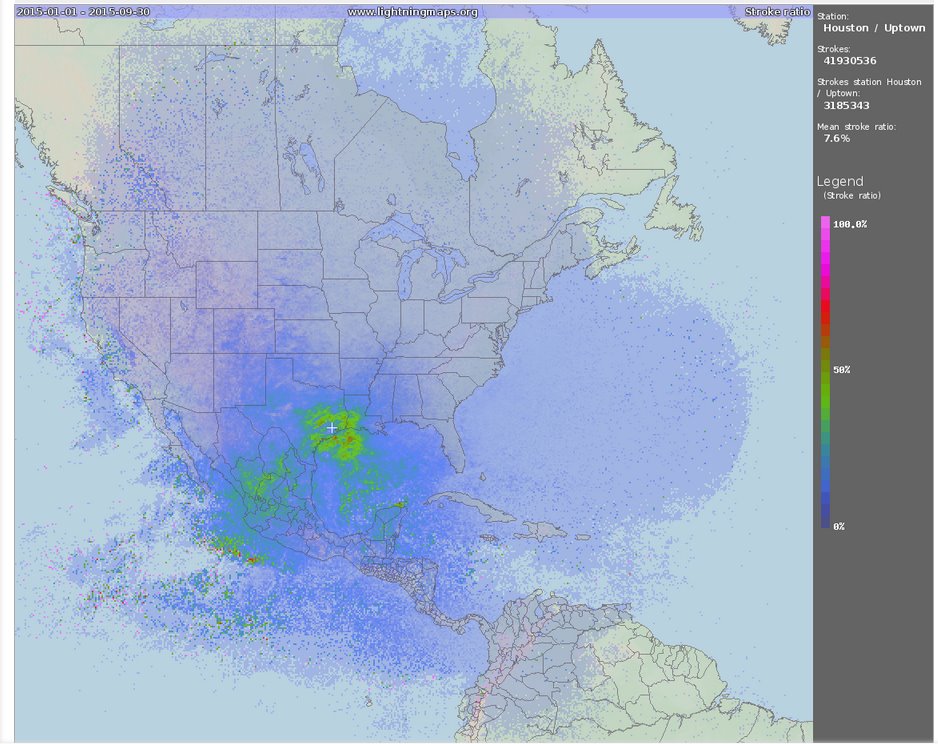Blitzortung
The Blitzortung project defines itself as a "worldwide, real time, community collaborative lightning location network" on its website. You can find it and much more information about the project under the URL "blitzortung.org". I became aware of the project and started to contribute by running a blitzortung detector station around the year 2012.Since the time I started to contribute two new upgraded detector hardware versions were introduced in 2013 (System Red) and 2016 (System Blue) which means I'm now running an outdated system with limited use for the overall network. I still have to decide if I want to upgrade to the newest Hardware or not, but because I had so much fun with assembly, running and especially optimizing my station I decided to document my experience here.
Operation principle
Each detector (station) is equipped with low frequency receive antennas. In the case of my older hardware this antennas consist of two orthogonal oriented ferrite rod antennas, but for the newer hardware design also other kinds of antennas are used. Especially lighning strikes between the clouds and the earth surface generate low frequency transmissions which are picked up by the antenna. If the signal of the received signal is strong enough to pass a certain threshould a microcontroller starts to record the signal for a certain amount of time. This recorded signal could be either be a picked up electrical disturbance or a real lighning strike.Beside the receiving antenna each station also consists of a GPS receiver which has two different purposes:
- First it determines and reports the location of the detector to the networks main calculation server
- Secondly it generates the 1PPS (1 pulse per second) signal which is derived from the GPS system and is used by the station to generate a precise synchronized time stamp for each received lighning strike
For all events that are reported by the required minimum amount of stations the server now takes all the received data pairs (consisting of time stamp and receiving station location) and calculates the most likely strike position which creates a "best-fit" for all stations that reported the same event between the strike position and their receiving time stamp and location data. Of course this calculation is based on the fact that the electrical signal triggered by the strike is traveling in all directions with the same speed and that stations further away will receive it later than close ones.
My Station (System Green)
Back in 2012 I ordered the necessary PCBs and the preprogrammed microcontroller for the assembly of my own station via the blitzortung website. Next I ordered the necessary electrical parts and I started the assembly process. Last but not least I ordered the necessary GPS module on Ebay and I bought a raspberry pi minicomputer which should act as the interface between the microcontroller and the blitzortung server.Main microprozessor PCB
The main station PCB containing the microprocessor and the analog to digital converters is shown below. I did some modifications to the circuitry which I will describe below. After the station was working properly everything was mounted into a case.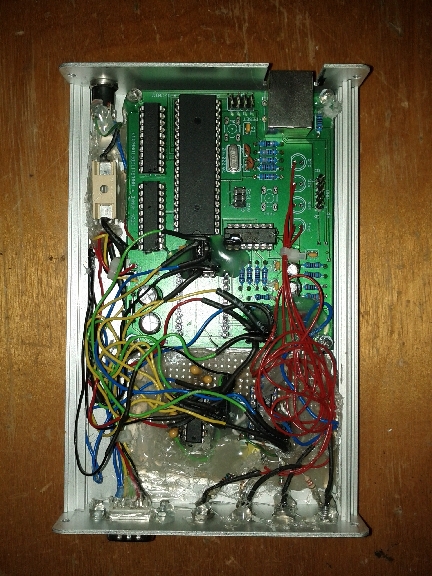

Originally the main PCB would have been communicating with the "gateway" computer to the blitzortung server via an USB breakout-board containing a FTDI interface chip. Because I prefer using a RS232 interface to the raspberry pi I added some circuitry containing a MAX232 device. This gave me also the opportunity to add another helpful feature: a GPS module debugging link option.
In the normal hardware configuration the station microprozessor is directly communicating with the serial interface of the GPS module. This does not allow easy access from the user PC to the GPS module output strings and without this information it is very difficult to find a good spot inside the house where the GPS receiver has good enough reception. Because I already modified the interface circuitry I added an additional digital multiplexer circuit that allows the raspberry pi to either talk with the main station microprozessor during normal operation, or with the GPS module serial interface during debugging mode. Which mode is active is set by the level of the serial interface control signals.
Receiving Antennas
The two receiver ferrite antennas are located inside the PVC installation pipes. Next to it the receiver PCB takes care that the small signals from the antenna are amplified properly before this signals are sent to the main microprozessor PCB for analog to digital conversion. This also makes sure that the signals still have a good SNR ratio during the final conversion into the digital domain. The antenna PCB also contains some jumpers which allow to set the gain of the preamplifiers. This is the main parameter for optimization of the stations receiving performance. I had a lot of fun finding the optimal gain settings over time.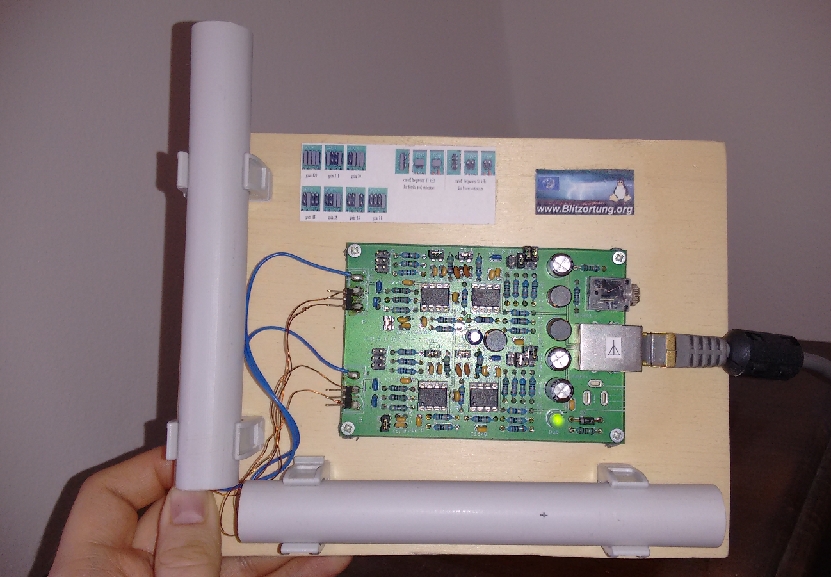
GPS module
A EM-406A GPS module is used for determination of the stations location and for providing the GPS system time which is needed for generation of the correct event timestamps inside the main PCB microprozessor when a lightning strike is detected. GPS basically makes sure that all timers in all blitzortung stations are synchronized to each other, and that their transmitted timestamps can be related and compared to each other. Because the signal triggered by the strike travels with the speed of light this time stamps have to be very accurate, because every time error translates directly to strike location calculation errors. The module does communicate with the microprozessor via a serial interface using standardized NMEA messages.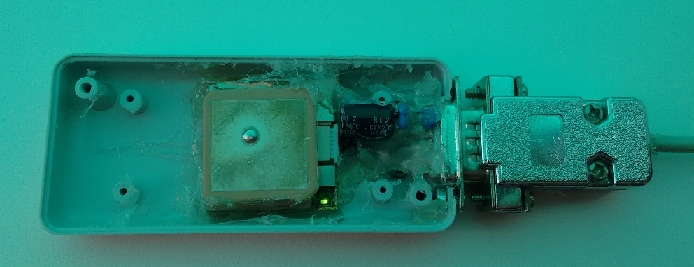
For debugging of the GPS module and its state I wrote a small terminal program which opens the serial port, receives and decodes all NMEA messages sent by the GPS module and ouputs them using the ncurses library. The most useful output information is the field "satellites which are visible to the module". Using this information it is very easy to find the best location for the GPS receiver. An example output of the debugging program is shown below. Because I was using ssh to access the raspberry pi the graphical output of the program was not 100% correct. Additionally I made all location information unreadable.
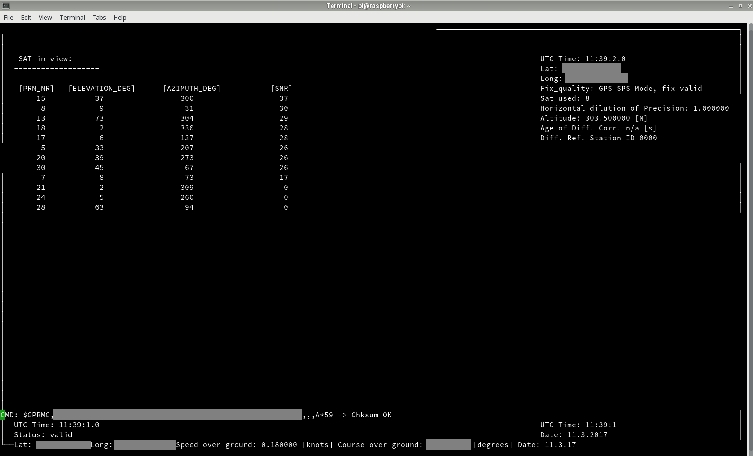
Overall setup: Graz (2013)
The first generation raspberry pi is communicating with the main PCB microprozessor via an USB-to-RS232 converter. The pi itself is connected to the internet via an ethernet connection to our router. This also allows control of the pi via SSH. I run the XLT 3 tracker which establishes and handles the connection between my station and the blitzortung server. The two pictures below show my first station setup in the city of Graz in Austria until the end of the year 2013.
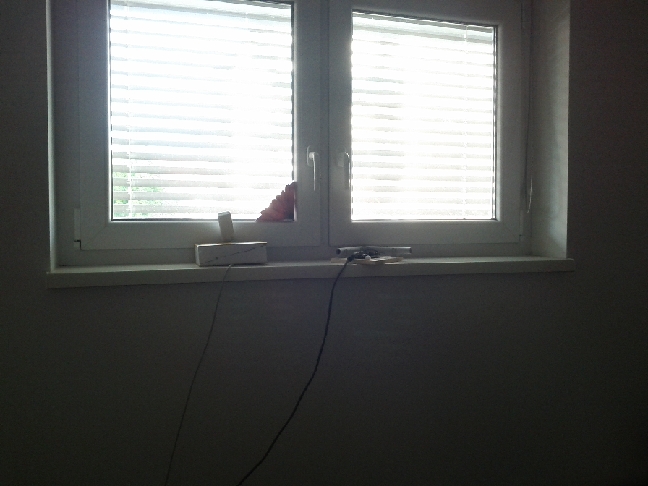
At the end of the year 2013 I relocated to Houston. The final statistics for Graz are shown below. Overall my station transmitted 1.1M signals to the blitzortung server, and the server confirmed the succesful reception of 416k strikes. Unfortunately I had to keep my gain setting and with it the sensitivity of the station low, because somewhere below our appartement was a source of a 25kHz disturbance signal which limited me. Nevertheless I was sometimes able to receive strikes from the coast of North Africa and from Turkey. My reception of signals north of the alps was rather weak.
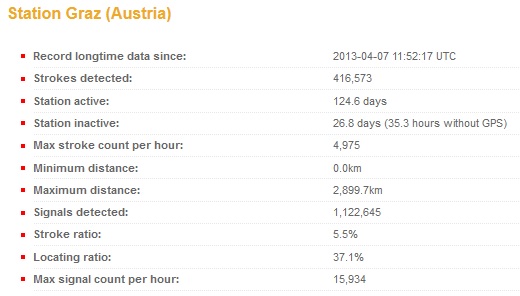
Houston/TX (2014-2015)
Compared to Europe where the Blitzortung network was started and the network already consisted of several hundred of stations Region North America was only started during the year 2013 and much less detectors were already present. Therefore every station made a big difference for the overall network and I was really excited to restart my station after relocation. I almost become the first and only station in Houston, but unfortunately somebody was a little bit faster than me. Nevertheless I was one of less than 10 stations in Texas at this point in time.Especially during summer the detector was receiving lightning strikes without any break even though I also used a rather low gain setting. After two years my station had received an impressive number of over 5M confirmed strikes over a distance of up to 7678 km.
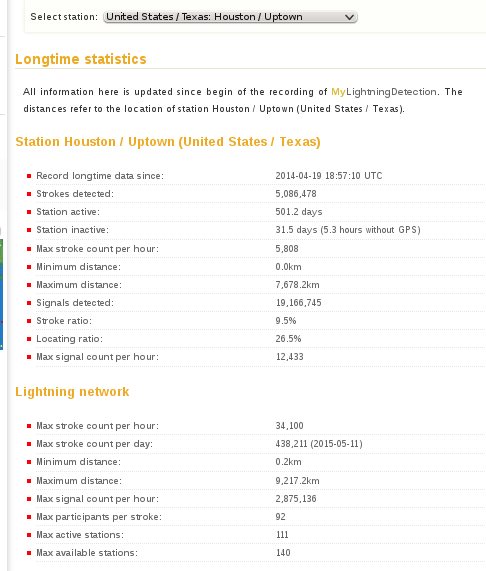
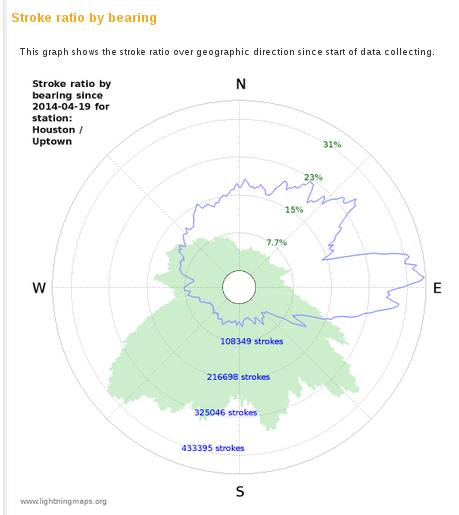
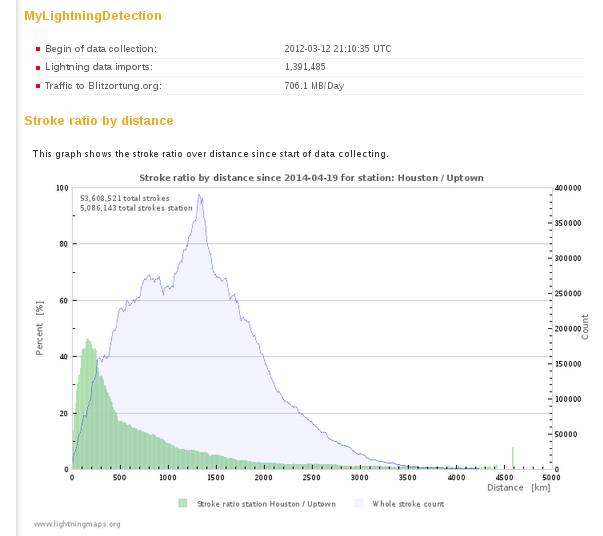
The map below indicates the reception area. I had very good reception over the Golf of Mexico, Mexico and Texas.
